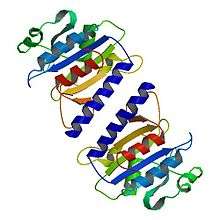Ste5

Ste5 is a MAPK scaffold protein involved in the mating of yeast. The active complex is formed by interactions with the MAPK Fus3, the MAPK kinase (MAPKK) Ste7, and the MAPKK kinase Ste11. After the induction of mating by an appropriate mating pheromone (either a-factor or α –factor) Ste5 and its associated proteins are recruited to the membrane.
Ste4 helps to recruit Ste5, Ste4 is not required for the attachment of Ste5 to the membrane. Membrane association depends on a pleckstrin homology domain, as well as an amphipathic alpha-helical domain in the amino terminus.[1]
During mating, Fus3 MAPK and Ptc1 phosphatase compete to control 4 phosphorylation sites on the Ste5 scaffold. When all of 4 sites have been dephosphorylated by Ptc1, Fus3 is released and becomes active.[2]
Ste5 plays 2 main roles in the mating signal pathway:
- Binds the components of the MAPK cascade and holds them in an active complex [3]
- Associates with the membrane, bringing the kinases to the membrane and promoting amplification of the signal (concentrating the bound kinases).[4] Ste5 remains stably bound at the plasma membrane.[5]
Ste5 oligomerization is very important for stable membrane recruitment. In one model, the activation of the pathway occurs at the same time that Ste5 is converted from a less active, closed form of Ste5 to an active Ste5 dimer that can bind to the beta-gamma subunit of the heterotrimeric G-protein and form a lattice for the MAPK cascade to assemble on.[6]
Not only does Ste5 contribute to propagation of the pheromone signal, but it is also involved in down regulating of signalling. It stimulates autophosphorylation of Fus3, which results in phosphorylation of Ste5, causing a downregulation in signalling.[7]
Ste5 also catalytically unlocks Fus3 (but not it’s homologue Kss1) for phosphorylation by Ste7. Both this catalytically active Ste5 domain as well as Ste7 are required for full Fus3 activation, which explains why Fus3 is activated by only the mating pathway, and remains inactive during other pathways which also utilize Ste7.[8]
Ste5 can be localized to the cytoplasm, mating projection tip, nucleus, and plasma membrane.[9]
Biological Processes
Ste5 is involved in the following biological processes:[9]
- Invasive growth in response to glucose limitation
- Negative regulation of the MAPK cascade
- Pheromone-dependent signal transduction involved in conjugation with cellular fusion
- Positive regulation of protein phosphorylation
- Regulation of RNA-mediated transposition
References
- ↑ Winters, Matthew (7 October 2005). "A Membrane Binding Domain in the Ste5 Scaffold Synergizes with Gβγ Binding to Control Localization and Signaling in Pheromone Response". Molecular Cell. 20 (1): 21–32. doi:10.1016/j.molcel.2005.08.020. Retrieved March 21, 2014. Garrenton, Lindsay (July 15, 2006). "Function of the MAPK scaffold protein, Ste5, requires a cryptic PH domain". Genes & Development. 20 (14): 1946–1958. PMC 1522084
 . PMID 16847350. doi:10.1101/gad.1413706.
. PMID 16847350. doi:10.1101/gad.1413706. - ↑ Malleshaiah, Mohan (6 May 2010). "The scaffold protein Ste5 directly controls a switch-like mating decision in yeast". Nature. 465 (7294): 101–105. PMID 20400943. doi:10.1038/nature08946. Retrieved March 21, 2014.
- ↑ Pryciak, Peter; Huntress, Frederick (September 1, 1998). "Membrane recruitment of the kinase cascade scaffold protein Ste5 by the Gβγ complex underlies activation of the yeast pheromone response pathway". Genes & Development. 12 (17): 2684–2697. PMC 317142
 . PMID 9732267. doi:10.1101/gad.12.17.2684.
. PMID 9732267. doi:10.1101/gad.12.17.2684. - ↑ Lamson, Rachel (21 March 2006). "Dual Role for Membrane Localization in Yeast MAP Kinase Cascade Activation and Its Contribution to Signaling Fidelity". Current Biology. 16 (6): 618–623. PMID 16546088. doi:10.1016/j.cub.2006.02.060. Retrieved March 21, 2014.
- ↑ van Drogen, Frank (24 October 2001). "MAP kinase dynamics in response to pheromones in budding yeast". Nature Cell Biology. 3 (12): 1051–1059. doi:10.1038/ncb1201-1051. Retrieved March 21, 2014.
- ↑ Elion, Elaine (November 15, 2001). "The Ste5p scaffold". Cell Science. 114 (22): 3967–78. Retrieved March 21, 2014.
- ↑ Bhattacharyya, Roby (10 February 2006). "The Ste5 Scaffold Allosterically Modulates Signaling Output of the Yeast Mating Pathway". Science. 311 (5762): 822–826. PMID 16424299. doi:10.1126/science.1120941. Retrieved March 21, 2014.
- ↑ Good, Matthew (20 March 2009). "The Ste5 Scaffold Directs Mating Signaling by Catalytically Unlocking the Fus3 MAP Kinase for Activation". Cell. 136 (6): 1085–1097. PMC 2777755
 . PMID 19303851. doi:10.1016/j.cell.2009.01.049.
. PMID 19303851. doi:10.1016/j.cell.2009.01.049. - 1 2 "Ste5". Saccaromyces Genome Database. SGD Project. 2007-07-04. Retrieved 21 March 2014.